MnROAD Tests Cracking on 70th Street
BY AsphaltPro Staff
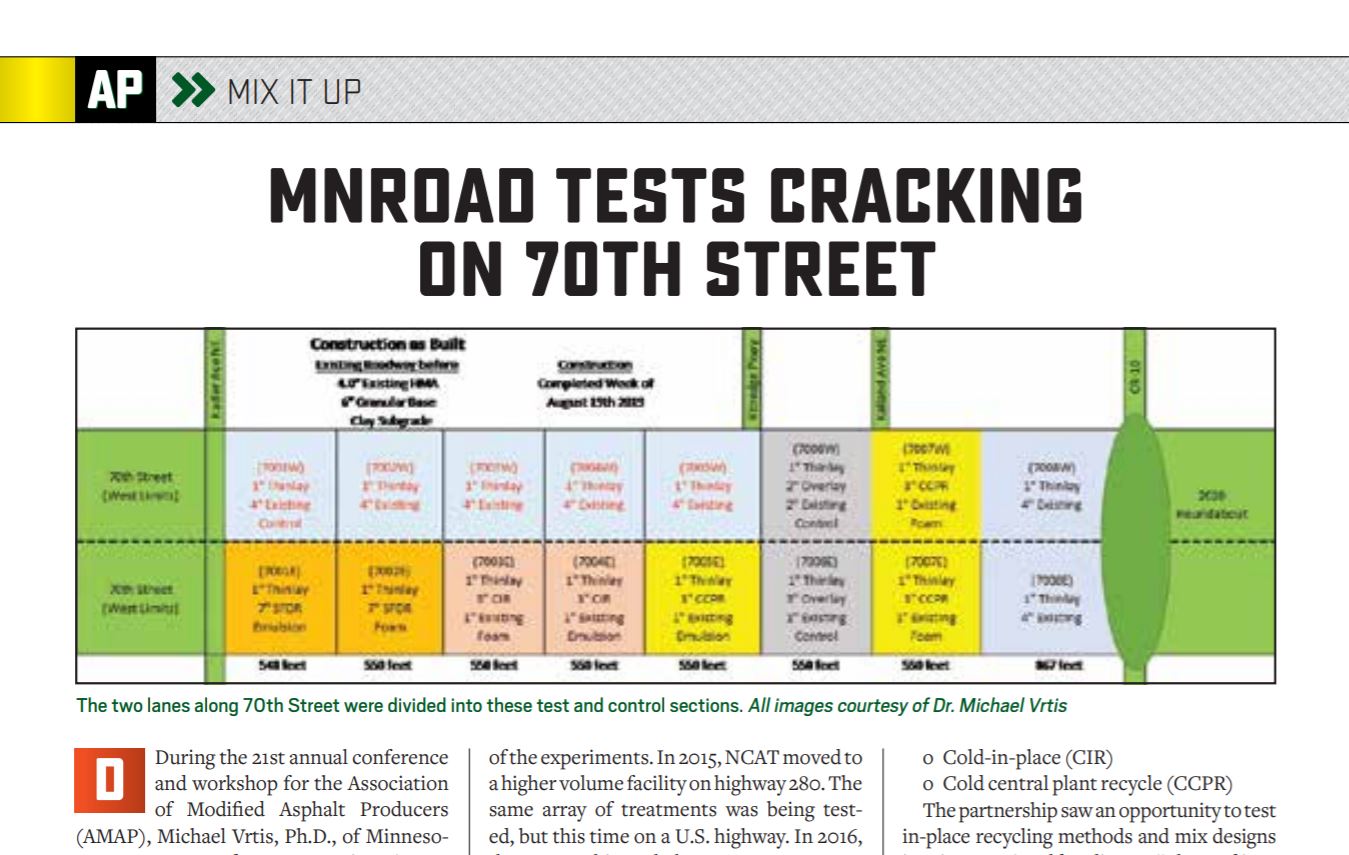
During the 21st annual conference and workshop for the Association of Modified Asphalt Producers (AMAP), Michael Vrtis, Ph.D., of Minnesota Department of Transportation (MnDOT), shared with the audience two research projects performed in the state. This article shares information from the cold recycling techniques performed on 70th Street going into the MnROAD facility. The September issue of PreservationPro will share information from the National Road Research Alliance Flexible Team’s mix recycling agent field study. Vrtis presented both of these Feb. 13.
The MnROAD and National Center for Asphalt Technology (NCAT) pavement preservation partnership had 24 partners as of early 2020, with more states showing interest. The partnership originated in 2012 with Minnesota and Alabama departments of transportation recognizing the different climate conditions in their states offer unique real-world challenges to preservation treatments being created and performed for testing. The partnership’s first preservation treatment test sections were built in Alabama in 2012 and over the next three to four years, they expanded to higher traffic volume roadways and completely different climates.
Lee County Road in Alabama was constructed in 2012 and marked the beginning of the experiments. In 2015, NCAT moved to a higher volume facility on highway 280. The same array of treatments was being tested, but this time on a U.S. highway. In 2016, the partnership took those same treatments from Lee 169 and from U.S. 280 to Minnesota and built them on two facilities in Pease, which is located in Mille Lacs County, which is about one and a half hours south of the Emily rejuvenator field testing project, which Vrtis describes in the upcoming September PreservationPro magazine.
Under this preservation partnership, there was a wide array of treatments, with the cold recycling treatments being performed in Alabama in the summer of 2015 (read about those test sections in “NCAT Offers Cold Recycle Mix Design” in the February 2020 edition of AsphaltPro):
- Control sections
- Surface treatments
o Crack sealing
o Fog seal
o Chip seals
o Scrub seals
o Micro surfacing
o Treatment combinations - Thin Overlays (3/4-inch)
o Dense-graded (4.75 mm)
o OGFC (Alabama and MnROAD)
o UTBWC
o Treatment combinations - Cold Recycling + Thin Overlay
o Cold-in-place (CIR)
o Cold central plant recycle (CCPR)
The partnership saw an opportunity to test in-place recycling methods and mix designs in Minnesota’s colder climate. “The road into MnROAD is one of the roughest roads I’ve ever been on in my life,” Vrtis told the AMAP audience in February. He took international roughness index (IRI) readings on the eastbound and westbound lanes of 70th Street leading to and from MnROAD (see graphic), which showed remarkably high numbers.

Driving on the pavement and looking at the IRI evidence showed a heavily distressed pavement that was a good candidate for some of the recycling techniques where the team could literally destroy the crack pattern and put on a new surface. The road sees an average daily traffic load of about 2,700 vehicles. The eastbound lane is in Albertville and the westbound lane is in Otsego, so two different municipalities with two different maintenance strategies had cared for the road over the years. MnROAD and NCAT took about a mile of the road—both sides—in a short time frame—from Aug. 19-23, 2019—to perform in-place work. They closed one lane at a time. They did seek out hot in-place recycling (HIR) methods to try on the section as well as the cold methods used.
“We were hoping we could get hot in-place recycling incorporated into this project,” Vrtis shared. “We thought we had it lined up…but the contractor didn’t think it was a good fit.” The contractor considered the underlying distress of the existing pavement and the fact the team wouldn’t be removing enough of the underlying system or causes of distress and withdrew. “They thought it wouldn’t be a fair showing for HIR because of the underlying distress.”
As that last-minute change demonstrates, there were a lot of moving pieces for the project. NCAT’s Buzz Powell coordinated the construction and all the moving pieces. Most of the equipment was donated or loaned for the project, with Powell coordinating that. The team brought in equipment from all over the country—equipment that had never been assembled together in a train. That’s why the stabilized full depth reclamation (SFDR) portion of the project went with a less conventional procedure; the reclaimer/stabilizer didn’t “fit” when the team went to insert it into the reclaiming train. Vrtis gave Powell the credit for managing the pieces to bring a revised reclamation train to the job.
The team that came together for this project included:
- Dr. Adriana Vargas, lead researcher for preservation project at NCAT
- Dr. Buzz Powell
- Mark Stahl and Wirtgen demo team, who brought a cold central plant and recycling equipment
- East Alabama Paving, who came for consistency
- Ingevity, who performed many emulsion designs
- Caterpillar, who loaned rollers
- Roadtec, who loaned paving equipment
- MnDOT Office of Materials and Road Research
- MnDOT Metro District
- City of Albertville
- City of Otsego
- Minnesota Paving and Materials
- American Engineering and Testing
- Midstate Reclamation
Vrtis explained the layout of the test sections shows the team incorporated three different technologies and everything within those technologies used foam and emulsion designs. The two lanes were divided into eight sections for a total of 16 “cells.” The existing pavement was constructed of a clay subgrade, 6 inches of granular base and 4 inches of hot-mix asphalt (HMA). The 16 cells allowed the partnership to perform SFDR, both a foam and an emulsion section; cold in-place recycling (CIR) with foam and emulsion; cold central plant recycling (CCPR) with foam and emulsion; several mill and inlay sections at various depths; and control sections will only a 1-inch thinlay.

The two lanes along 70th Street were divided into these test and control sections. All images courtesy of Dr. Michael Vrtis
Given the condition of the existing pavement, the team knew the thinlay wasn’t the proper fix, but it provided ideal control sections for the project. The thinlays were the minimum repair that could be taken to quickly improve the condition. Vrtis explained that the city needed something “to get them by” for the next two to three years while it worked on some development in the area. He acknowledged that the thinlay approach would not be a recommended treatment to correct the type of existing pavement distress they were working against.
Because this project took place near MnROAD and its stockpile area, the team was able to set up a mobile plant on the property for the cold central recycling. Wirtgen brought in and set up the cold central plant for the project. For the CCPR mixes, Ingevity prepared the emulsion design for section 7005 E with no cement. It included 3.5 percent PG58S-28 binder, and 2.5 percent optimum moisture content. NCAT prepared the foam design for sections 7007 E & W using 1 percent cement. It included 2.3 percent PG58S-28 binder, and 45 percent optimum moisture content.
The CIR was performed at a depth of 3 inches. With the foam design, NCAT prepared it for section 7003 E with 1 percent cement. It included 2.6 percent PG58S-28 and 4.5 percent optimum moisture content. Ingevity again prepared the CIR emulsion design for section 7004 E using no cement. It included 3.0 percent PG58S-28 and 2.0 percent optimum moisture content.
Local consultant, American Engineering and Testing, from the Twin Cities, designed the mix for the SFDR sections. The contractor spread the cement prior to the train coming over and performed the process at 7 inches depth. That included 4 to 5 inches of asphalt plus an additional 3 inches of base being milled and mixed with the cement. The emulsion design mix went directly into a paver. The foam SFDR mix was windrowed in front of a grader, which was followed by a padfoot compactor. The SFDR emulsion mix for section 7001 E incorporated 3.5 percent EE XX-28 binder, 6.0 percent optimum moisture and 1 percent cement. The SFDR foam mix for section 7002 E incorporated 2.5 percent PG58S-28 binder, 6.0 percent optimum moisture and 1 percent cement.
Within NCAT’s mobile testing lab, the team took samples and created cores.
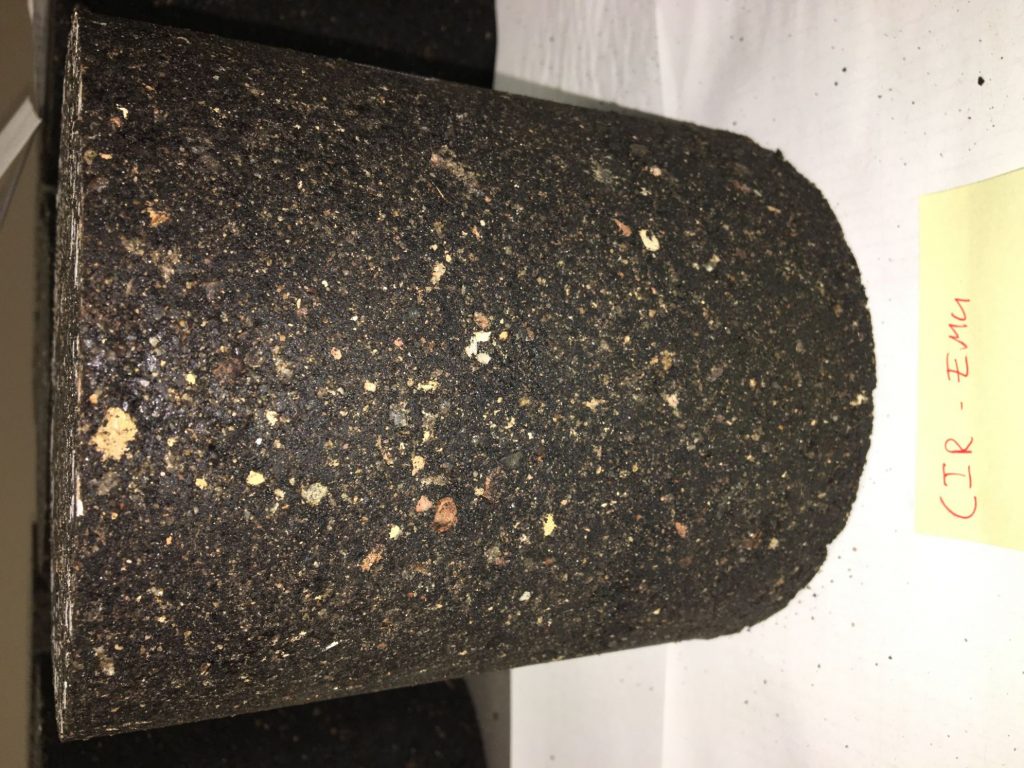
These two cores show the designs by Ingevity with no cement. The one on the left was placed via CIR method; the one on the right was placed via CCPR.
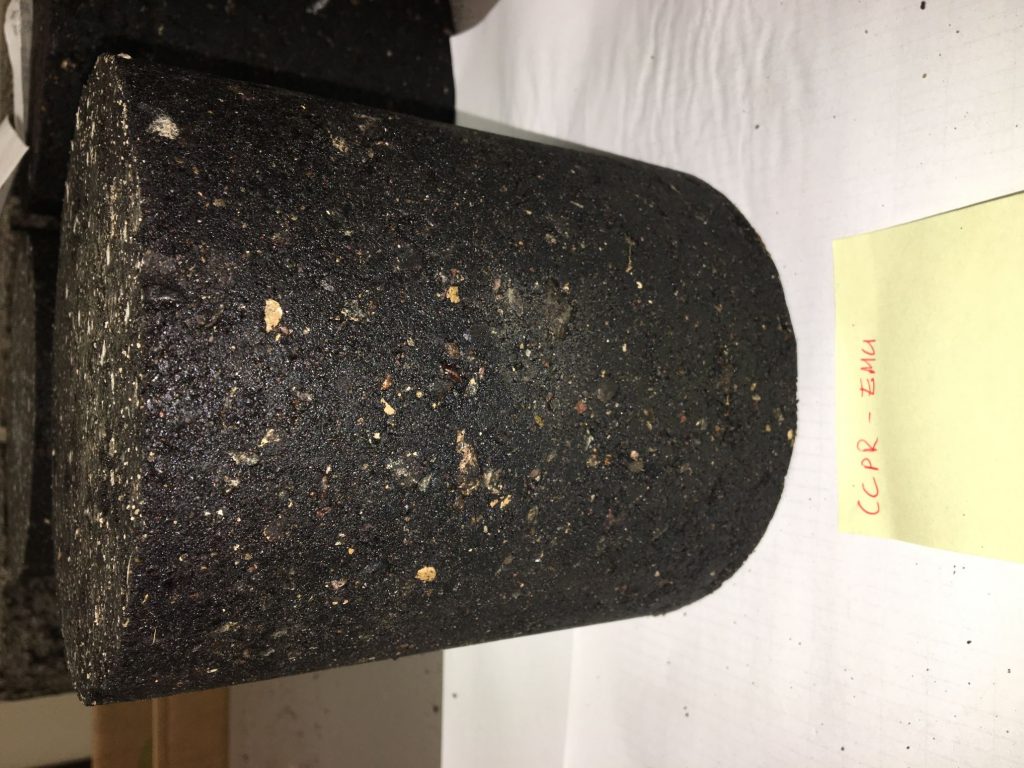
These two cores show the designs by Ingevity with no cement. The one on the left was placed via CIR method; the one on the right was placed via CCPR.
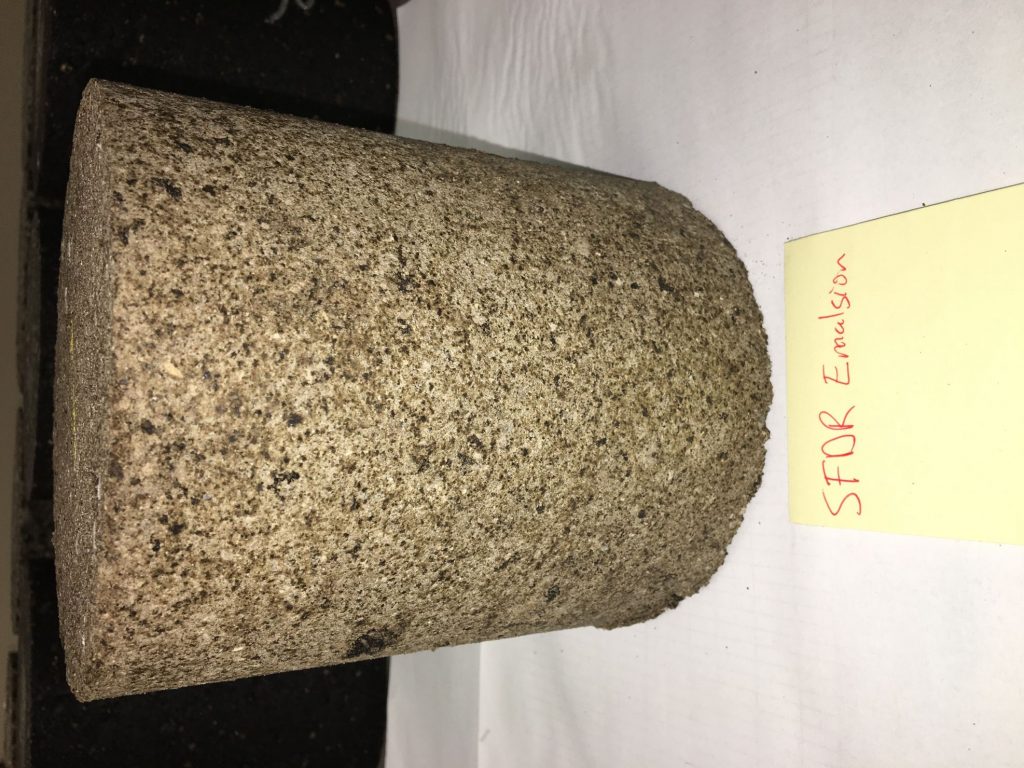
These two cores show the designs by American Engineering and Testing (AET) with 1 percent cement. The one on the left shows stabilized full depth reclamation with emulsion; the one on the right shows stabilized full depth reclamation with foam.
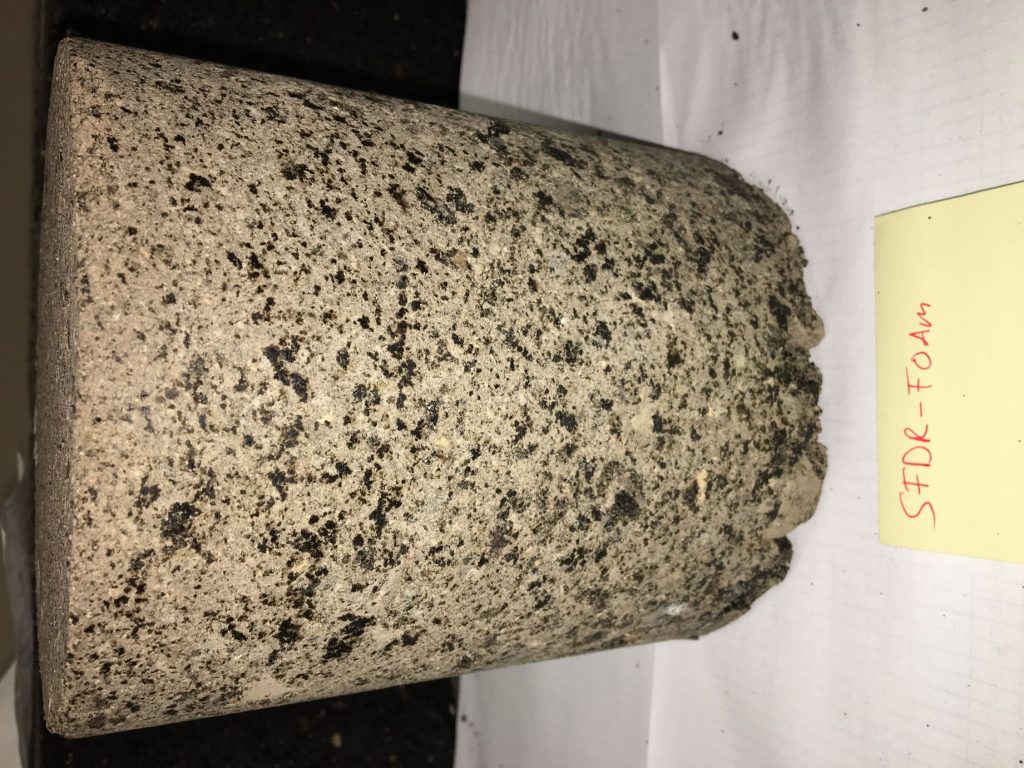
These two cores show the designs by American Engineering and Testing (AET) with 1 percent cement. The one on the left shows stabilized full depth reclamation with emulsion; the one on the right shows stabilized full depth reclamation with foam.
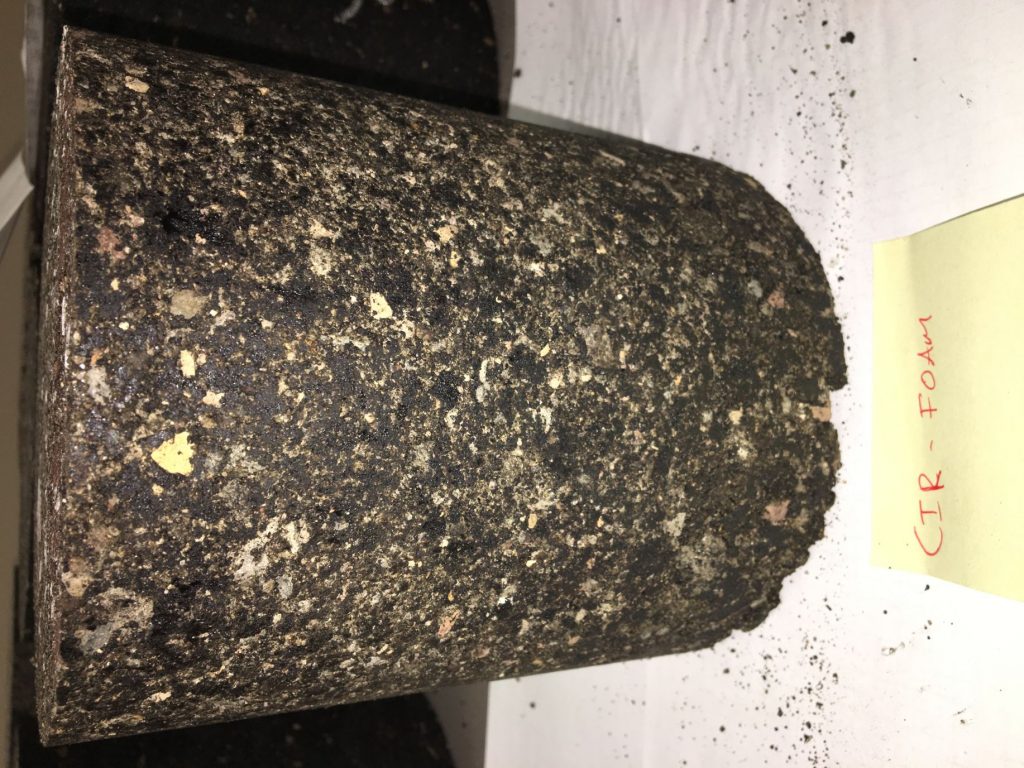
These two cores show the designs by the National Center for Asphalt Technology (NCAT) with 1 percent cement. The one on the left shows the CIR foam; the one on the right shows the CCPR foam.
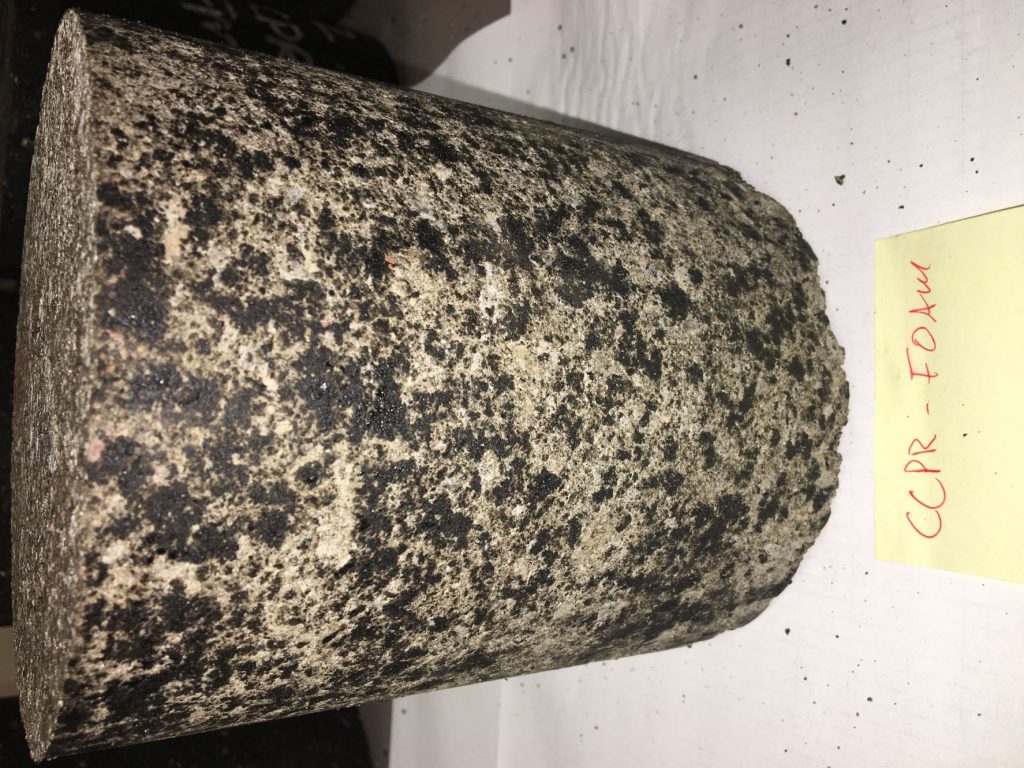
These two cores show the designs by the National Center for Asphalt Technology (NCAT) with 1 percent cement. The one on the left shows the CIR foam; the one on the right shows the CCPR foam.
At the end of the project, all test sections received a 1-inch HMA thinlay. Its design used 4.75-mm nominal maximum aggregate size, 20 percent RAP, and 6.4 percent PG58-28 binder. “This was a Buzz Powell special mix.”
As mentioned above, the thinlay was placed over the heavily distressed control sections as well.
As mentioned before, the roughness of the existing pavement was unacceptable. In October 2018, the eastbound lane average was 365.5 inches per mile and the westbound average was 304.25 inches per mile. A month after construction, Sept. 27, 2019, the eastbound average IRI was 78 inches per mile and the westbound average was 74.5 inches per mile. That’s from sections 7001 to 7008. All IRI values for individual cells and wheel paths are less than 90 inches per mile.
“Even the thinlay did a huge improvement for the ride,” Vrtis said.
After a cold snap in early December 2019, when temperatures were below 0oF, Vrtis noticed reflective cracks in the thinlay sections and some transverse cracks in the SFDR sections. Section 7001 (SFDR-E) had 86 inches of cracking; 7002 (SFDR-F) had 110 inches. Those transverse cracks in the SFDR sections surprised Vrtis because the team had, as he pointed out, “completely removed the existing cracking pattern there.” The SFDR sections will continue to be evaluated throughout the remainder of the study. “Although the early cracking was surprising in these sections, it is really the long-term performance that is important. It is still very early in the research and more work needs to be done to investigate the cause and monitor the potential distress progression.” The pre-existing condition of the pavement led researches to expect transverse, reflective and wheel path cracking would occur in the thin overlay sections, which they are seeing now. All rutting values were less than 0.125 inch.
The section’s performance will be monitored bi-weekly using MnDOT’s digital inspection vehicle, as all the sections of the preservation study are. The team is evaluating each treatment’s performance with respect to rutting, ride quality and cracking. Additionally, friction and noise are measured on an annual basis.
As a side note, teams from Virginia Transportation Research Center, University of California-Davis and University Nevada-Reno working on NCHRP 09-62 Phase 2 Testing came out to perform between-lab comparisons of preservation methods. It gave them the opportunity to see what kind of tests can be performed to assess when the mix is ready to open to traffic. MnDOT performed nuclear density testing as well as light-weight deflectometer testing.
Source: Michael Vrtis, Ph.D., is a research project engineer with Minnesota Department of Transportation (MnDOT) Office of Materials and Road Research (OMRR). For more information, contact him at Michael.vrtis@state.mn.us.
